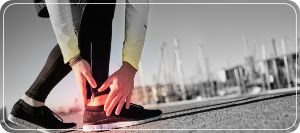Sprained Ankle Treatment Specialist in Jersey City, NJ
A sprained ankle is a common ailment that happens when one or more ankle ligaments strain or tear. Pain, swelling, bruising, and difficulty walking or bearing weight on the injured ankle are all symptoms of a sprained ankle. Rest, ice, compression, elevation, and physical therapy are all options for treating a sprained ankle. It is critical to see a healthcare provider if you have a sprained ankle. At Harborside Sport & Spine, David Sylvester DC and his team will serve you with the right treatment. For more information, contact us or schedule an appointment online. We are conveniently located at 75 Montgomery Street, Suite 603 Jersey City, NJ 07302.




Table of Contents:
What is the best first-aid treatment for a sprain?
How long might it take for a sprain or strain to heal?
What are the differences between a strain and a sprain?
How do I know if my ankle sprain is serious?
While your ligaments are quite strong, they can become injured, ligaments are like elastic bands that are connected from one bone to another bone and hold your joints in place. A sprain can occur when the ligament has a tear occur in the fibers of the ligament. There are two different types of tears that can occur with a sprain:
● Partial tear
● Complete tear
The most common sprain we often see at Harborside Sport & Spine is an ankle sprain, with knee, wrist, and thumb sprains coming in after. Patients will notice a sprain quite easily, as the area will begin to swell quite quickly and feel painful. If you are dealing with a minor sprain, in which the pain is not as intense, and can be easily managed at home, treatment can also be applied easily at home by following the R.I.C.E method.
R – Rest
If you want to rest the injured limb, we often recommend not putting any weight on the limb for 48 to 72 hours, as this will allow the limb to start the healing process without a re-injury occurring so soon after. A splint or a brace may also be recommended if a doctor thinks it is necessary.
I – Ice
Icing the area that you sprained can help the swelling to go down. You can use items like a compression sleeve filled with cold water, a cold pack, or even submerge the injured area in a slush bath. It’s best to ice the injury almost immediately after for 15 to 20 minutes. Continue icing the area 4-8 times per day for the first 48 hours after the injury or until you start to notice swelling improving.
C – Compress
Applying a compress with a bandage, or elastic wrap can also help with swelling.
E – Elevate
Elevating the injured area above your heart when you can help to limit or even prevent swelling from occurring.
Taking care of a sprain is not an overnight transition, it takes days and even weeks for a sprain to fully heal. If you do not see an improvement in the sprain, immediately visit your doctor for further review and diagnosis.
As well, if the sprain is providing a lot of pain, and the R.I.C.E method is not helping, visit your doctor for further help.
The severity of the sprain will depend on the length of time it will take for it to heal. We may not fully know the full extent of damage that a sprain caused unless diagnostic testing is completed to see what occurred. On average, we have noticed many moderate sprains to take about 3 to 4 weeks to heal enough to feel like you can continue with daily tasks and activities again without issues. More severe sprains can take 3 to 6 months to fully heal before moving on to daily tasks and activities again without issue.
You can easily heal a sprain with the proper information, particularly if you visit a doctor for a proper diagnosis, rest, and the correct rehabilitation methods to help you improve your sprain and mend it faster.
A sprain is considered a tear of a ligament(s) – this is when the tough bands of fibrous tissue that connects two bones within the joints become injured. The most common treatment option to help a sprain is the R.I.C.E. method which consists of rest, ice, compression, and elevation. Mild sprains can easily be treated at home, while more severe sprains may require surgery to help repair any partially or fully torn ligaments.
Symptoms of a sprain include:
• Pain
• Swelling
• Bruising
• Hearing or feeling a “bang”
• Limited mobility in the affected joint
A strain is when there is an injury to the muscle or the band of tissues that are attached to the muscle and bone. Symptoms of a strain include:
• Pain
• Tenderness
• Redness
• Bruises
• Limited mobility
• Muscle spasms
• Swelling
• Muscle weakness
Ankle sprains are a common injury often occurring during physical activity, such as sports or exercise. While some ankle sprains can be treated at home, some will require medical attention. Some signs that your ankle sprain is serious include:
● Severe pain – Significant pain and swelling around the ankle is a sign of a severe ankle sprain.
● Limited mobility – If you’re having difficulty moving your ankle or putting weight on it, this may indicate a serious injury.
● Bruising – Significant bruising around your ankle often signifies severe injury.
● Instability – If your ankle feels unstable or gives way when you stand or walk, you likely have a severe sprain.
If you’re experiencing any of these symptoms, it’s a wise idea to seek medical attention. A healthcare professional can evaluate your injury and recommend the most suitable course of treatment. This usually includes rest, ice, compression, and physical therapy. In certain cases, the terms “sprained ankle” and “twisted ankle” are often used interchangeably, they actually refer to different injuries. A sprained ankle occurs when the ankle ligaments are stretched or torn, usually as a result of rolling the ankle.
On the other hand, a twisted ankle generally refers to a sudden, awkward movement that causes the ankle to turn or rotate beyond its normal range of motion. This can cause pain and discomfort but does not always result in a sprain. While a twisted ankle may not always lead to a sprain, it’s important to take care of the injury to prevent further damage and future ankle sprains.
If you are having symptoms of a sprained ankle, you should get medical attention. For more information, contact us or schedule an appointment online. We serve patients from Jersey City NJ, Hoboken NJ, Weehawken NJ, West New York NJ, Guttenberg NJ, Secaucus NJ, Harrison NJ, Kearny NJ, Newark NJ, Belleville NJ, Lyndhurst NJ, East Orange NJ and Elizabeth NJ.
Check Out Our 5 Star Reviews


Chiropractic and Physical Therapy Services
▸ Chiropractic
▸ Physical Therapy
▸ Massage Therapy
▸ Acupuncture
▸ Spinal Decompression
▸ Prenatal Chiropractor
▸ Ear Infections
▸ Foot Pain
▸ Headaches
▸ Scoliosis
▸ Slipped Disc
▸ Sprained Ankles
▸ Stress
▸ Frozen Shoulder
▸ Osteoporosis
▸ Shoulder Pain






